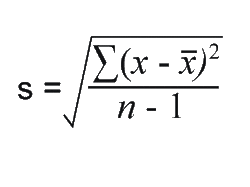How do I determine the standard deviation?
The standard deviation is the commonly used measure of variability when working with numeric data. It indicates how much, on average, each score in a set varies from the mean value of that set. It is usually represented by “s” or SD and is indicated as a +/- value. This single value demonstrates how much variability or dispersion is among scores in a set. To calculate the value, we must compute the deviation of each score from the mean and then determine the average amount of that deviation across all scores> The formula we use for samples is:

The steps for using this formula are as follows:
- Calculate the mean (x̅) of a set of data
- Subtract the mean from each point of data to determine (x-x̅). You’ll do this for each data point, so you’ll have multiple (x-x̅).
- Square each of the resulting numbers to determine (x-x̅)2. As in step 2, you’ll do this for each data point, so you’ll have multiple (x-x̅)2.
- Add the values from the previous step together to get ∑(x-x̅)2. Now you should be working with a single value.
- Calculate (n-1) by subtracting one from your sample size. Your sample size is the total number of data points you collected.
- Divide the answer from step 4 by the answer from step 5
- Calculate the square root of your previous answer to determine the standard deviation.
- Be sure your standard deviation has the same number of units as your raw data, so you may need to round your answer.
- The standard deviation should have the same unit as the raw data you collected. For example, SD = +/- 0.5 cm.
An example calculation for this data set is the number of seconds needed to complete a task: 14, 10, 14, 12, 19, 15, 7, 8, 15, 16
- Calculate the mean of all scores. In the example, it would be 13 seconds.
- Subtract each score from the mean. For example 19-13=6
- Square each of the deviations. For example, 6 squared is 36.
- Sum all of the squared deviations from all the scores. In the example, it would be 126.
- Divide this sum by the number of observations minus 1. In the example, that would be 10-1=9. Dividing 126 by 9 equals 14.
- Compute the square root of 14, which is 3.74. The standard deviation for this set of scores would be +/- 3.74.
Additional common questions:
- Why do we square the deviations from the mean? To make each value positive; otherwise, the sum would be zero.
- Why do we calculate a square root? We calculate the square root in the last step to return the values to their original units.
- What does the SD represent? Each standard deviation represents a distance from the mean of a set of scores.
- How would I report this? You would report the mean and the SD of a set of scores. In our example, we would report the set had a mean value of 13 +/-3.74 seconds.
This video demonstrates how to calculate the SD of a sample in Excel.
8 thoughts on “How do I determine the standard deviation?”
Hello.This article was extremely remarkable, especially because I was browsing for thoughts on this issue last Friday.
I needed to thank you for this excellent read!! I definitely loved every little bit of it. Ive got you saved as a favorite to look at new stuff you postÖ
I was more than happy to find this site. I wanted to thank you for ones time just for this wonderful read!! I definitely liked every little bit of it and I have you bookmarked to check out new information on your blog.
Please can I share this piece from you? It’s easy-to-understand advice worth sharing! My friends would find value in this too.
This is relevant advice for my friends, so I’ll link back to
this article and you should likely get a few extra readers.
It’s better than anything else out there when it comes to this subject.
Thanks for the fresh info!
Thank you for your help and this post. It’s been great.
Great work! This is the type of information that should be shared around the net. Shame on the search engines for not positioning this post higher! Come on over and visit my website . Thanks =)
Greetings! I’ve been following your blog for some time now and finally got the courage to go ahead and give you a shout out from Atascocita Tx! Just wanted to mention keep up the fantastic job!